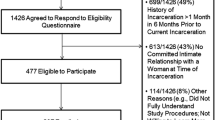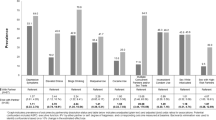Abstract
Incarceration is strongly associated with HIV infection and may contribute to viral transmission by disrupting stable partnerships and promoting high-risk partnerships. We investigated incarceration and STI/HIV-related partnerships among a community-based sample recruited for a sexual behavior interview while frequenting venues where people meet sexual partners in a North Carolina city (N = 373). Men reporting incarceration in the past 12 months were more likely than men without recent incarceration to experience multiple new sexual partnerships (unadjusted prevalence ratio [PR] 1.8, 95% confidence interval [CI]: 1.1–3.1) and transactional sex defined as trading sex for money, goods, or services (unadjusted PR: 4.0, 95% CI: 2.3–7.1) in the past 4 weeks. Likewise, women who were ever incarcerated were more likely than never-incarcerated women to experience recent multiple new partnerships (unadjusted PR: 3.1, 95% CI: 1.8–5.4) and transactional sex (unadjusted PR: 5.3, 95% CI: 2.6–10.9). Sexual partnership in the past 12 months with someone who had ever been incarcerated versus with partners with no known incarceration history was associated with recent multiple new partnerships (men: unadjusted PR 2.0, 95% CI 1.4–2.9, women: unadjusted PR 4.8, 95% CI 2.3–10.1) and transactional sex (men: unadjusted PR 3.3, 95% CI 1.7–6.6, women: unadjusted PR 6.1, 95% CI 2.4–15.4). Adjustment for demographic and socioeconomic variables had minimal effect on estimates. However, the strong overlap between incarceration, partner incarceration, and substance abuse had substantial effects in multivariable models. Correctional-facility and community-based HIV prevention, with substance abuse treatment, should reach currently and formerly incarcerated individuals and their sexual partners.
Similar content being viewed by others
References
Maruschak LM. HIV In Prisons, 2001. Washington, DC: Department of Justice, Bureau of Justice Statistics; 2004.
Centers for Disease Control and Prevention. HIV/AIDS Surveillance Report 2005, Volume 17, 2006.
Hammett TM. HIV/AIDS, sexually transmitted diseases, and incarceration among women: national and southern perspectives. Sex Transm Dis. 2006;33:S17–S22.
Adimora AA, Schoenbach VJ, Martinson FE, et al. Heterosexually transmitted HIV infection among African Americans in North Carolina. J Acquir Immune Defic Syndr. 2006;41:616–623.
Manhart LE, Aral SO, Holmes KK, Foxman B. Sex partner concurrency: measurement, prevalence, and correlates among urban 18–39-year-olds. Sex Transm Dis. 2002;29:133–143.
Adimora AA, Schoenbach VJ, Martinson FE, Donaldson KH, Stancil TR, Fullilove RE. Concurrent partnerships among rural African Americans with recently reported heterosexually transmitted HIV infection. J Acquir Immune Defic Syndr. 2003;34:423–429.
Adimora AA, Schoenbach VJ, Martinson F, Donaldson KH, Stancil TR, Fullilove RE. Concurrent sexual partnerships among African Americans in the rural south. Ann Epidemiol. 2004;14:155–160.
Tyndall MW, Patrick D, Spittal P, Li K, O’Shaughnessy MV, Schechter MT. Risky sexual behaviours among injection drugs users with high HIV prevalence: implications for STD control. Sex Transm Infect. 2002;78(Suppl 1):i170–i175.
North Carolina Department of Heath and Human Services. N. C. HIV/STD Surveillance Report 2006. Raleigh, NC: Epidemiology Section, Division of Public Health, North Carolina Department of Health & Human Services; 2006.
Weir SS, Pailman C, Mahlalela X, Coetzee N, Meidany F, Boerma JT. People to places: focusing AIDS prevention efforts where it matters most. AIDS. 2003;17:895–903.
Zeger SL, Liang KY. Longitudinal data analysis for discrete and continuous outcomes. Biometrics. 1986;42:121–130.
McNutt LA, Wu C, Xue X, Hafner JP. Estimating the relative risk in cohort studies and clinical trials of common outcomes. Am J Epidemiol. 2003;157:940–943.
Zou G. A modified poisson regression approach to prospective studies with binary data. Am J Epidemiol. 2004;159:702–706.
Zocchetti C, Consonni D, Bertazzi PA. Estimation of prevalence rate ratios from cross-sectional data. Int J Epidemiol. 1995;24:1064–1065.
Maldonado G, Greenland S. Simulation study of confounder-selection strategies. Am J Epidemiol. 1993;138:923–936.
Bureau of Justice Statistics. Prison and Jail Inmates at 2003. Washington, DC 2004.
Comfort M, Grinstead O, McCartney K, Bourgois P, Knight K. “You Can’t Do Nothing in This Damn Place”: sex and intimacy among couples with an incarcerated male partner. J Sex Res. 2005;42:3–12.
Lowenstein A. Coping with stress: the case of prisoner’s wives. J Marriage Fam. 2005;46:699–708.
Comfort M. ‘Papa’s house’: the prison as domestic and social satellite. Ethnography. 2002;3:467–499.
Browning S, Miller S, Lisa M. Criminal incarceration dividing the ties that bind: Black men and their families. J Afr Am Men. 2001;6:87–102.
Moore J. Bearing the burden: how incarceration weakens inner-city communities. In: Fulbright K, ed. The Unintended Consequences of Incarceration. New York: Vera Institute of Justice; 1996.
Rindfuss R, Stephen EH. Marital noncohabitation: separation does not make the heart grow fonder. J Marriage Fam. 1990;52:259–270.
Schneller D. Prisoner’s families: a study of some social and psychological effects of incarceration on the families of negro prisoners. Criminology. 1975;12:402–412.
Adimora AA, Schoenbach V. Social context, sexual networks, and racial disparities in rates of sexually transmitted infections. J Infect Dis. 2005;191:S115–S122.
Visher C, La Vigne NG, Travis J. Maryland pilot study: Findings from Baltimore. Washington, DC: Urban Institute Justice Policy Center; 2004.
MacGowan RJ, Margolis A, Gaiter J, et al. Predictors of risky sex of young men after release from prison. Int J STD AIDS. 2003;14:519–523.
Belenko S, Peugh J. Estimating drug treatment needs among state prison inmates. Drug Alcohol Depend. 2005;77:269–281.
Meade CS. Sexual risk behavior among persons dually diagnosed with severe mental illness and substance use disorder. J Subst Abuse Treat. 2006;30:147–157.
Somlai AM, Kelly JA, McAuliffe TL, Ksobiech K, Hackl KL. Predictors of HIV sexual risk behaviors in a community sample of injection drug-using men and women. AIDS Behav. 2003;7:383–393.
CDC. Drug-Associated HIV Transmission Continues in the United States. Accessed March 2006. Available at: http://www.cdc.gov/hiv/pubs/facts/idu.htm. National Center for HIV, STD and TB Prevention, Divisions of HIV/AIDS Prevention, Centers for Disease Control and Prevention; 2002b.
Kral AH, Bluthenthal RN, Lorvick J, Gee L, Bacchetti P, Edlin BR. Sexual transmission of HIV-1 among injection drug users in San Francisco, USA: risk-factor analysis. Lancet. 2001;357:1397–1401.
Strathdee SA, Galai N, Safaiean M, et al. Sex differences in risk factors for hiv seroconversion among injection drug users: a 10-year perspective. Arch Intern Med. 2001;161:1281–1288.
Booth RE, Kwiatkowski CF, Chitwood DD. Sex related HIV risk behaviors: differential risks among injection drug users, crack smokers, and injection drug users who smoke crack. Drug Alcohol Depend. 2000;58:219–226.
Gorman EM, Carroll RT. Substance abuse and HIV: considerations with regard to methamphetamines and other recreational drugs for nursing practice and research. J Assoc Nurses AIDS Care. 2000;11:51–62.
Molitor F, Ruiz JD, Flynn N, Mikanda JN, Sun RK, Anderson R. Methamphetamine use and sexual and injection risk behaviors among out-of-treatment injection drug users. Am J Drug Alcohol Abuse. 1999;25:475–493.
Wingood GM, DiClemente RJ. The influence of psychosocial factors, alcohol, drug use on African-American women’s high-risk sexual behavior. Am J Prev Med. 1998;15:54–59.
Castillo Mezzich A, Tarter RE, Giancola PR, Lu S, Kirisci L, Parks S. Substance use and risky sexual behavior in female adolescents. Drug Alcohol Depend. 1997;44:157–166.
Dinwiddie SH. Characteristics of injection drug users derived from a large family study of alcoholism. Compr Psychiatry. 1997;38:218–229.
Iguchi MY, Bux DA, Jr. Reduced probability of HIV infection among crack cocaine-using injection drug users. Am J Public Health. 1997;87:1008–1012.
Shrier L, Emans S, Woods E, Durant R. The association of sexual risk behaviors and problem drug behaviors in high school students. J Adolesc Health. 1996;20:377–383.
Hudgins R, McCusker J, Stoddard A. Cocaine use and risky injection and sexual behaviors. Drug Alcohol Depend. 1995;37:7–14.
Graves KL, Leigh BC. The relationship of substance use to sexual activity among young adults in the United States. Fam Plann Perspect. 1995;27:18–22, 33.
Strunin L, Hingson R. Alcohol, drugs, and adolescent sexual behavior. Int J Addict. 1992;27:129–146.
Catania JA, Gibson DR, Chitwood DD, et al. Methodological problems in AIDS behavioral research: influences on measurement error and participation bias in studies of sexual behavior. Psychol Bull. 1990;108:339–362.
Acknowledgments
This study was supported by a grant from the University of North Carolina Center for AIDS Research (9P30A150410) and the National Institute of Drug Abuse via RO1 MH068719-01. The conclusions expressed here are solely the responsibility of the authors and do not necessarily represent the views of the funders.
The authors thank Sherri Harris and Sandy Michael of NIA Community Action Center, Willie Garrison of the Wright Focus Group, and Nancy Jackson of the UNC-CH Center for AIDS Research for their leadership in the field and insights into study findings; all members of the NC PLACE Steering Committee for guidance and support through the study planning, implementation, and dissemination; the NC PLACE Study interviewing team members for their diligence; and members of the UNC-CH Bridges to Good Health and Treatment (BRIGHT) Working Group for their consistent support during NC PLACE field and data analysis activities, with particular thanks to Monique Williams, Tracina Williams, Danielle Haley, Becky Stephenson-White, Anna Scheyette, Carol Golin, and Andrew Kaplan. We dedicate this research to the memories of Andrew Kaplan and Willie Garrison, who continue to inspire our efforts to prevent HIV transmission in North Carolina and beyond.
Author information
Authors and Affiliations
Corresponding author
Additional information
Khan, Weir, Adimora, Kaufman, and Miller are with the Department of Epidemiology, School of Public Health, University of North Carolina, Chapel Hill, NC, USA; Wohl is with the Center for AIDS Research, University of North Carolina, Chapel Hill, NC, USA; Wohl, Adimora, and Miller are with the Division of Infectious Diseases, School of Medicine, University of North Carolina, Chapel Hill, NC, USA; Weir is with the The MEASURE Evaluation Project, Carolina Population Center, University of North Carolina, Chapel Hill, NC, USA; Moseley is with the Guilford County Department of Public Health, Greensboro, NC, USA; Norcott is with the Sickle Cell Disease Association of the Piedmont, Guilford County, NC, USA; Duncan is with the Triad Health Project, Guilford County, NC, USA.
Rights and permissions
About this article
Cite this article
Khan, M.R., Wohl, D.A., Weir, S.S. et al. Incarceration and Risky Sexual Partnerships in a Southern US City. J Urban Health 85, 100–113 (2008). https://doi.org/10.1007/s11524-007-9237-8
Received:
Accepted:
Published:
Issue Date:
DOI: https://doi.org/10.1007/s11524-007-9237-8




